Assessment of the Economic and Environmental Impact of Double Glazed Façade Ventilation Systems in Mediterranean Climates
Abstract
:1. Introduction
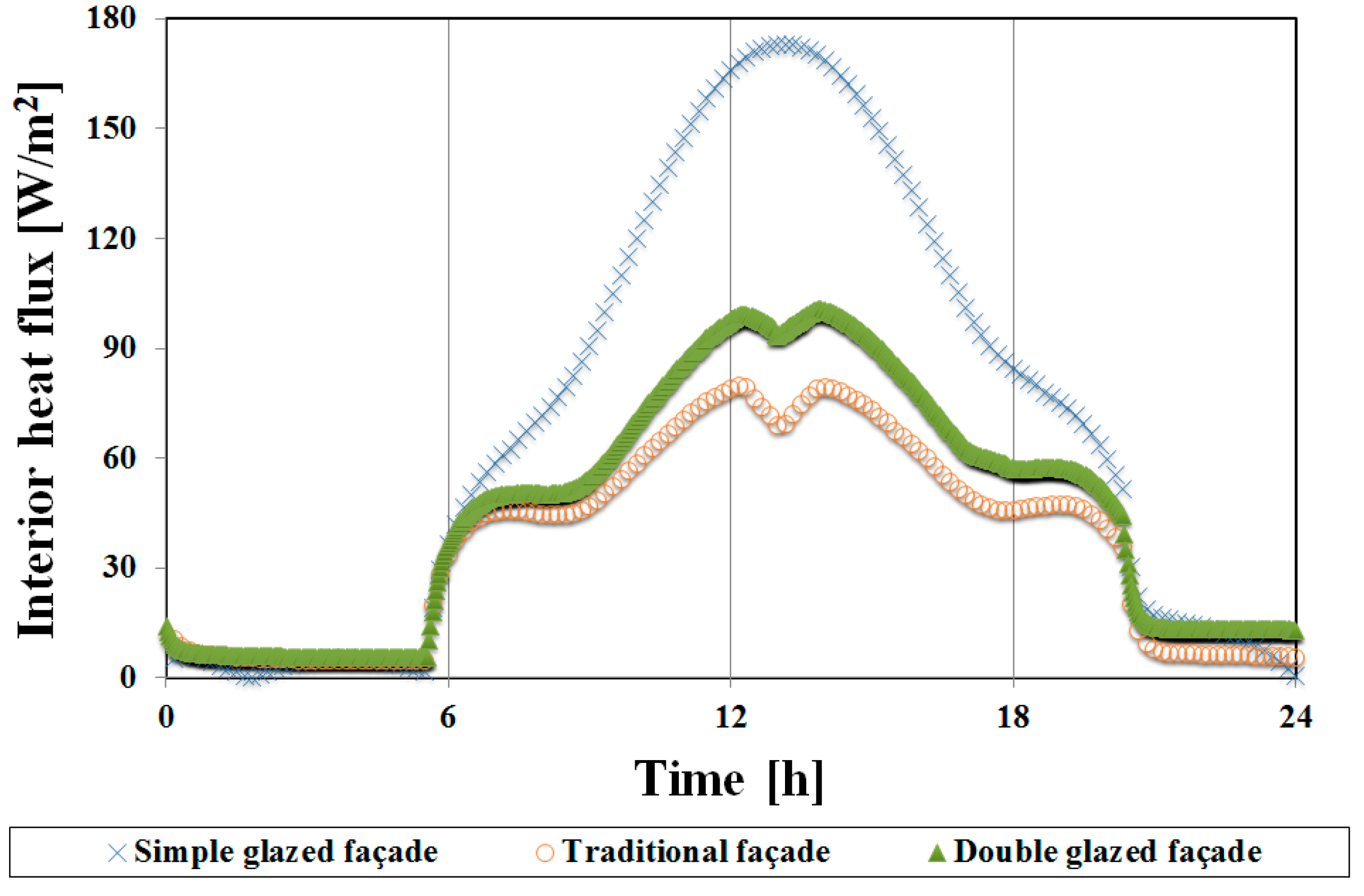
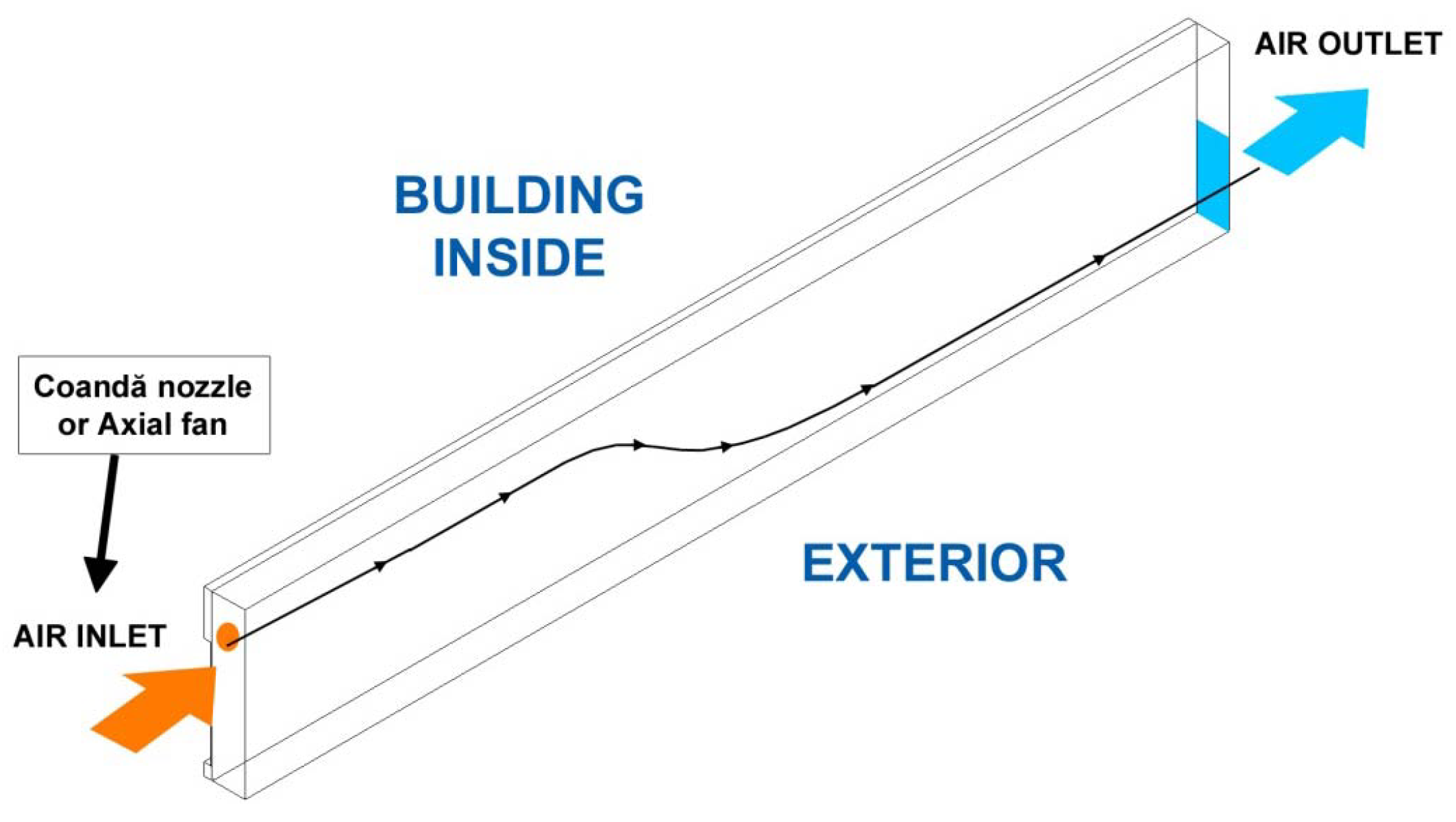
2. Previous Works
- -
- Fans need an electrical grid connection, so they have to meet strict fire hazard regulations;
- -
- A solid support has to be built-up in the lateral side of the façade in order to install them;
- -
- Fans have rotating components, such as motor or bearings, which require maintenance;
- -
- They also generate vibration and noise.
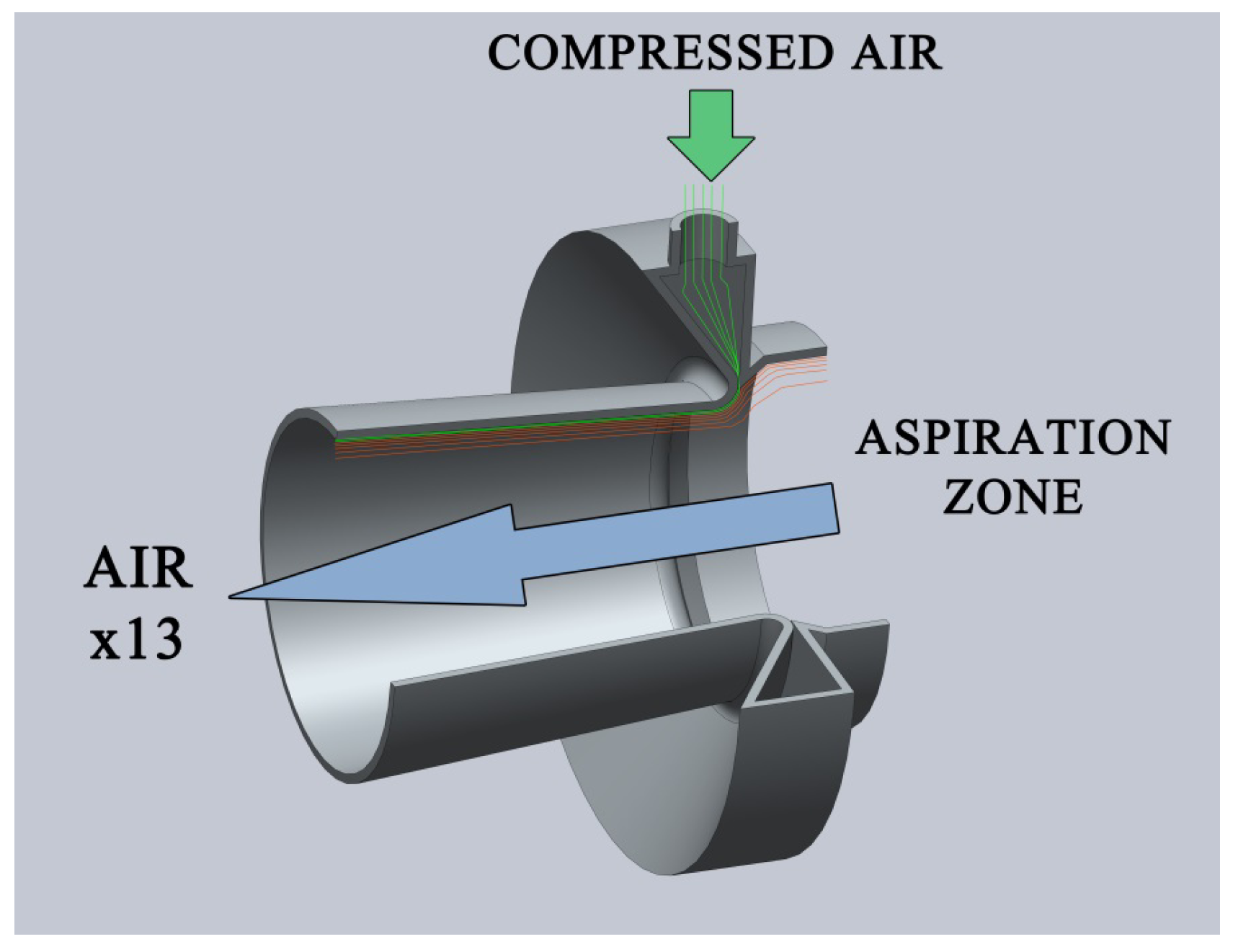
- -
- They do not need maintenance because they have no moving parts;
- -
- They do not generate vibration;
- -
- They are light and compact structures;
- -
- They implement a flow regulation system adjusting only the pressure of the injected air;
- -
- Coandă nozzles do not need any electrical connections, so they do not have to comply with any safety requirements;
- -
- Coandă nozzles generate low level noise and its origin is exclusively aerodynamic.

3. Economic Study
| Cost | Coandă nozzles | Fans |
|---|---|---|
| Initial investment |
|
|
| Operating costs |
|
|
| Maintenance costs |
|
|
3.1. Initial Investment
| Air flow requirements of a Coandă nozzle (m3/s) | Pressure requirements in the Coandă nozzles’ inlet (kPa) | Air flow requirements of the whole air compressed installation (m3/s) | Blower pressure (kPa) | Blower power (kW) |
|---|---|---|---|---|
| 0.04 | 1.38 | 0.13 | 2.50 | 1 |
| 0.09 | 4.87 | 0.26 | 9.50 | 4 |
| 0.12 | 11.56 | 0.37 | 21.50 | 8 |
| 0.15 | 23.78 | 0.44 | 39.50 | 20 |
| 0.16 | 41.65 | 0.48 | 60.00 | 30 |

3.2. Operating Costs
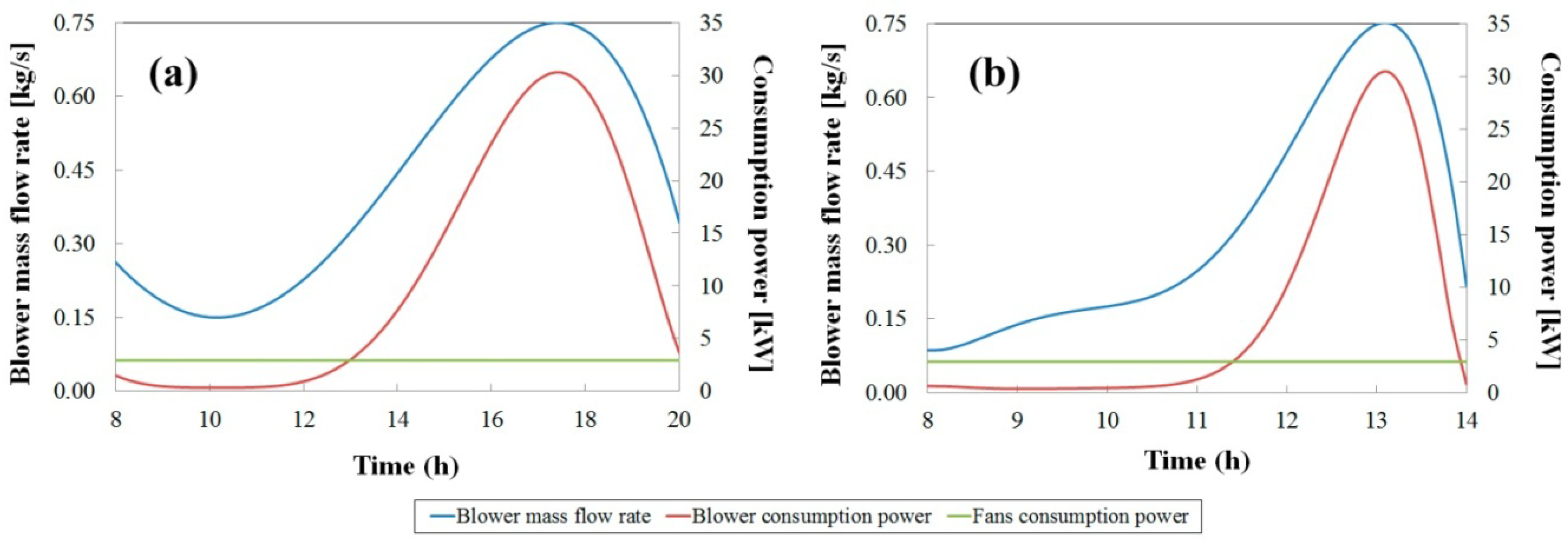
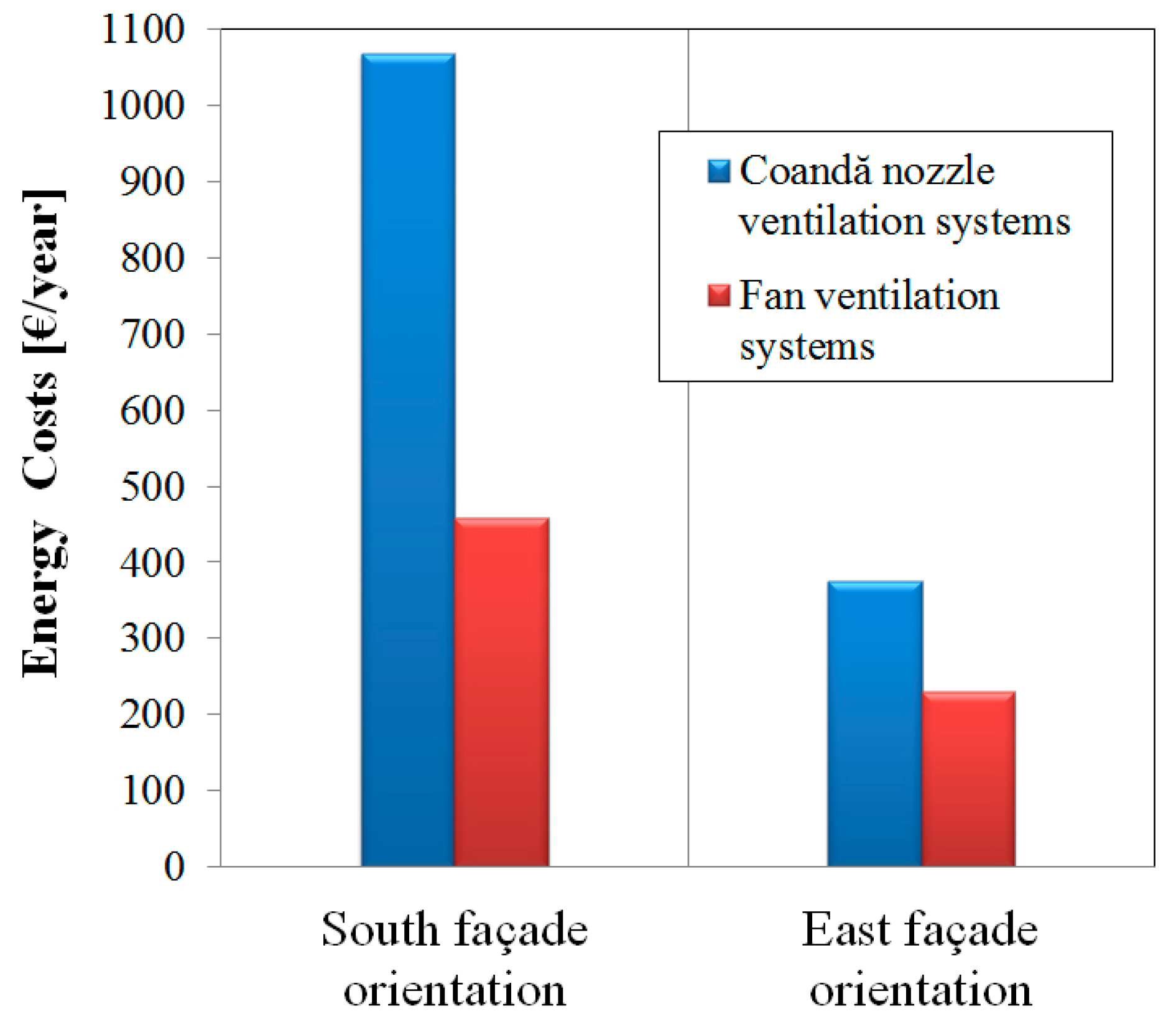
3.3. Maintenance Costs

3.4. Total Costs Comparison
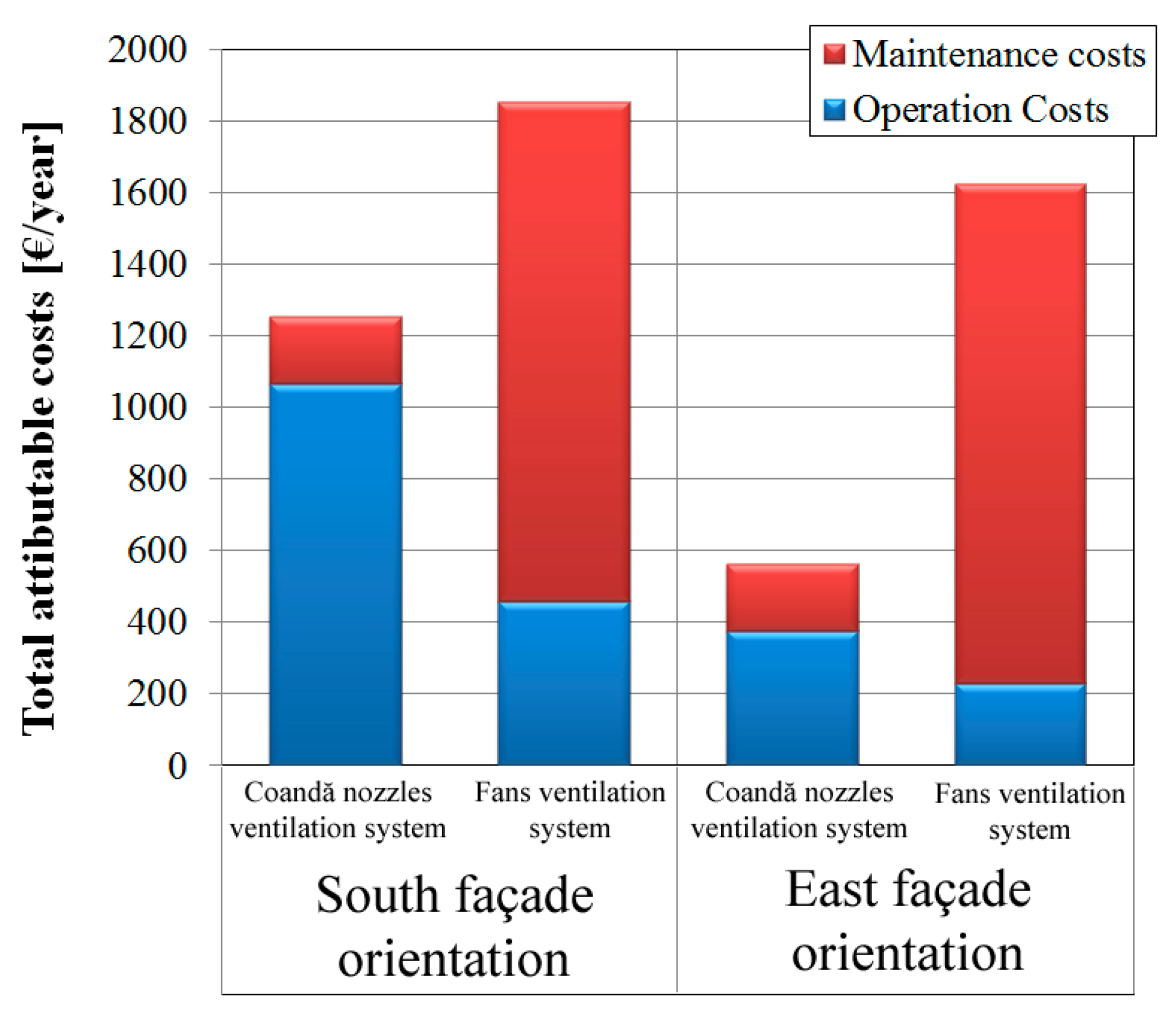
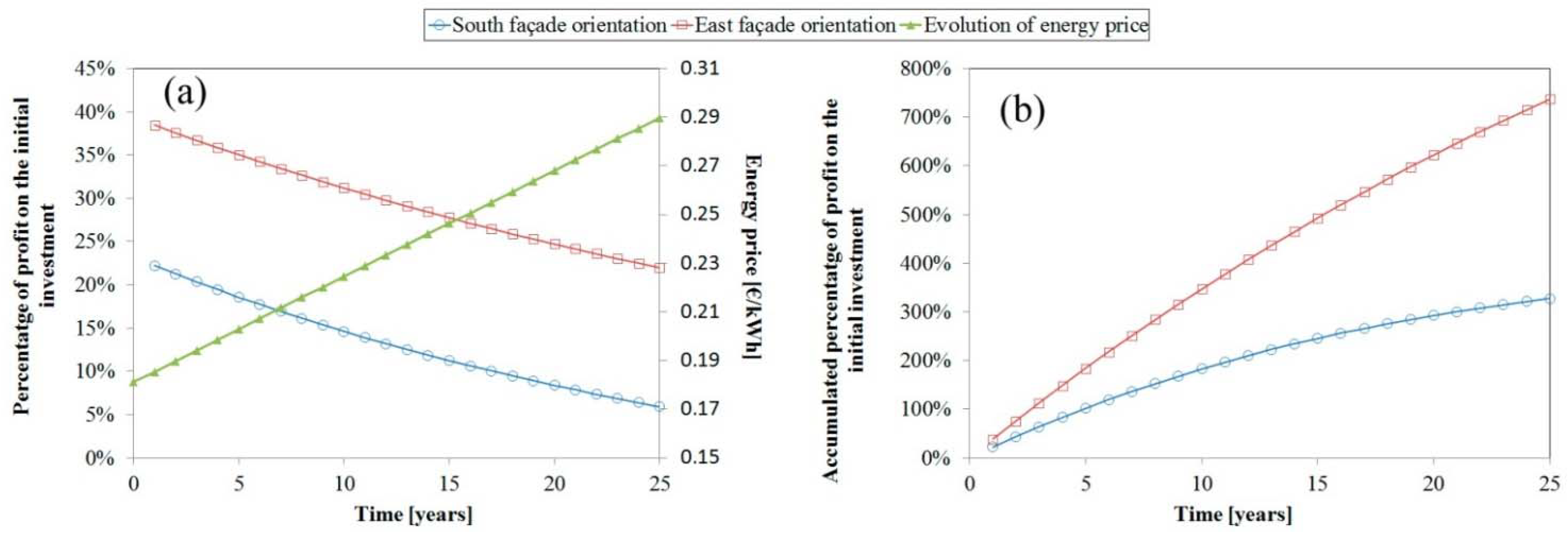
4. Environmental Impact Estimation
4.1. Life Cycle Assessment

4.1.1. Material Production and Manufacturing
| Fans ventilation system | Weight (kg/unit) | Coandă nozzles ventilation system | Weight (kg/unit) |
|---|---|---|---|
| Fans | - | Coandă nozzles | - |
| Steel and sheet metal | 18 | Plastic | 32 |
| Copper | 2 | Blower or compressor | - |
| Aluminum | 5 | Steel and sheet metal | 110 |
| Plastic | 1 | Copper | 4 |
| - | - | Aluminum | 10 |
| - | - | Plastic | 10 |
| - | - | Natural rubber | 1 |
| Material | Fans (MJ/life cycle) | Coandă nozzles (MJ/life cycle) | ||||||
|---|---|---|---|---|---|---|---|---|
| Renewable | Non-Renewable | Embodied | Total | Renewable | Non-Renewable | Embodied | Total | |
| Steel and sheet metal | 270.00 | 2392.20 | 141.75 | 2803.95 | 220.00 | 1949.20 | 115.50 | 2284.70 |
| Copper | 61.35 | 666.30 | 0 | 727.65 | 16.36 | 177.68 | 0 | 194.04 |
| Aluminum | 87.00 | 1674.00 | 1071.38 | 2832.38 | 23.20 | 446.40 | 285.70 | 755.30 |
| Plastic | 102.53 | 719.10 | 0 | 821.63 | 1457.22 | 10,220.81 | 0.00 | 11,678.03 |
| Natural rubber | - | - | - | - | 1.00 | 36.30 | 56.11 | 93.41 |
| Total | 520.88 | 5451.60 | 1213.13 | 7185.60 | 1717.78 | 12,830.39 | 457.31 | 15,005.48 |

4.1.2. Operating Energy Consumption
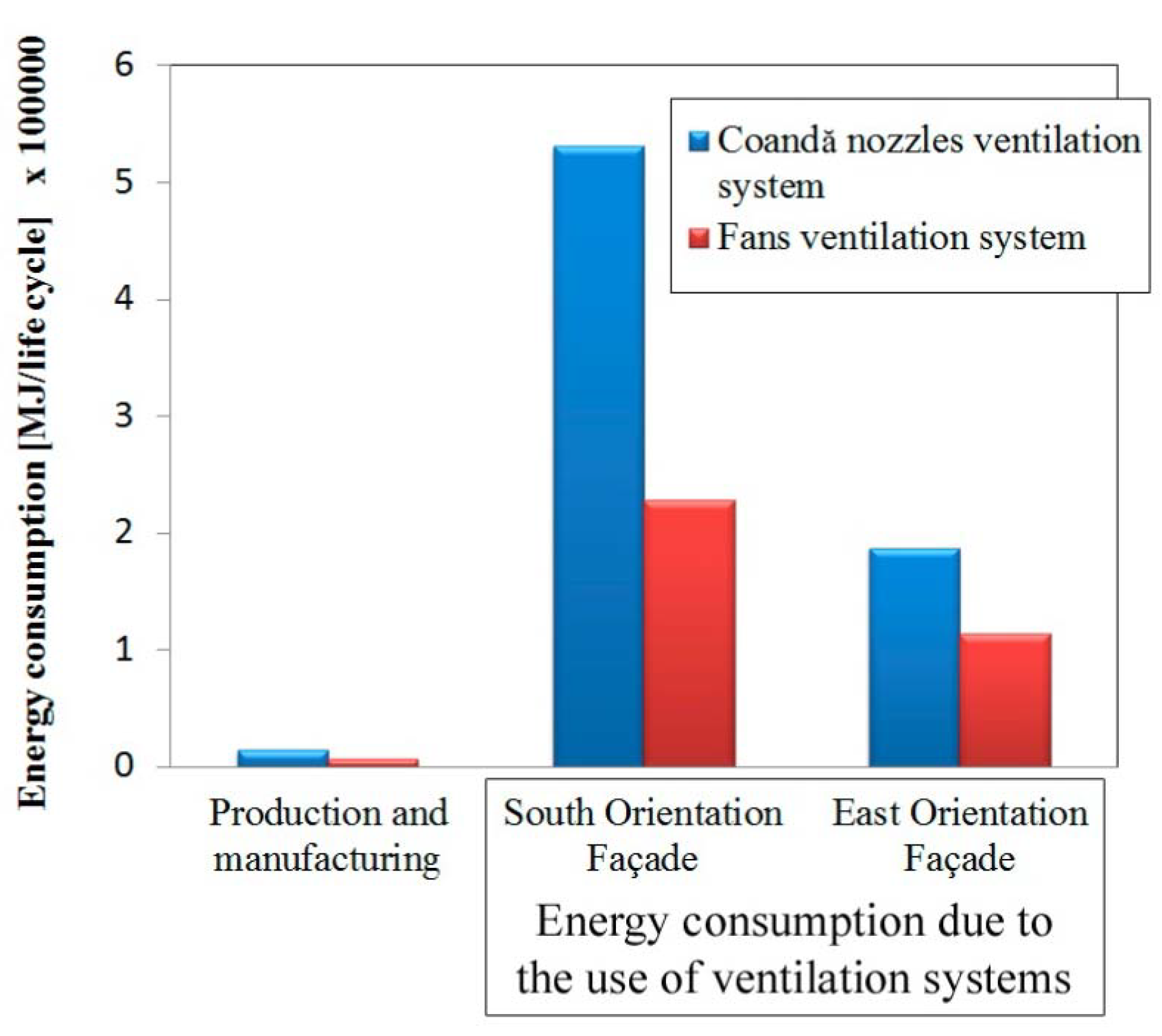
4.2. Energy Savings Produced through the Use of Forced Ventilation


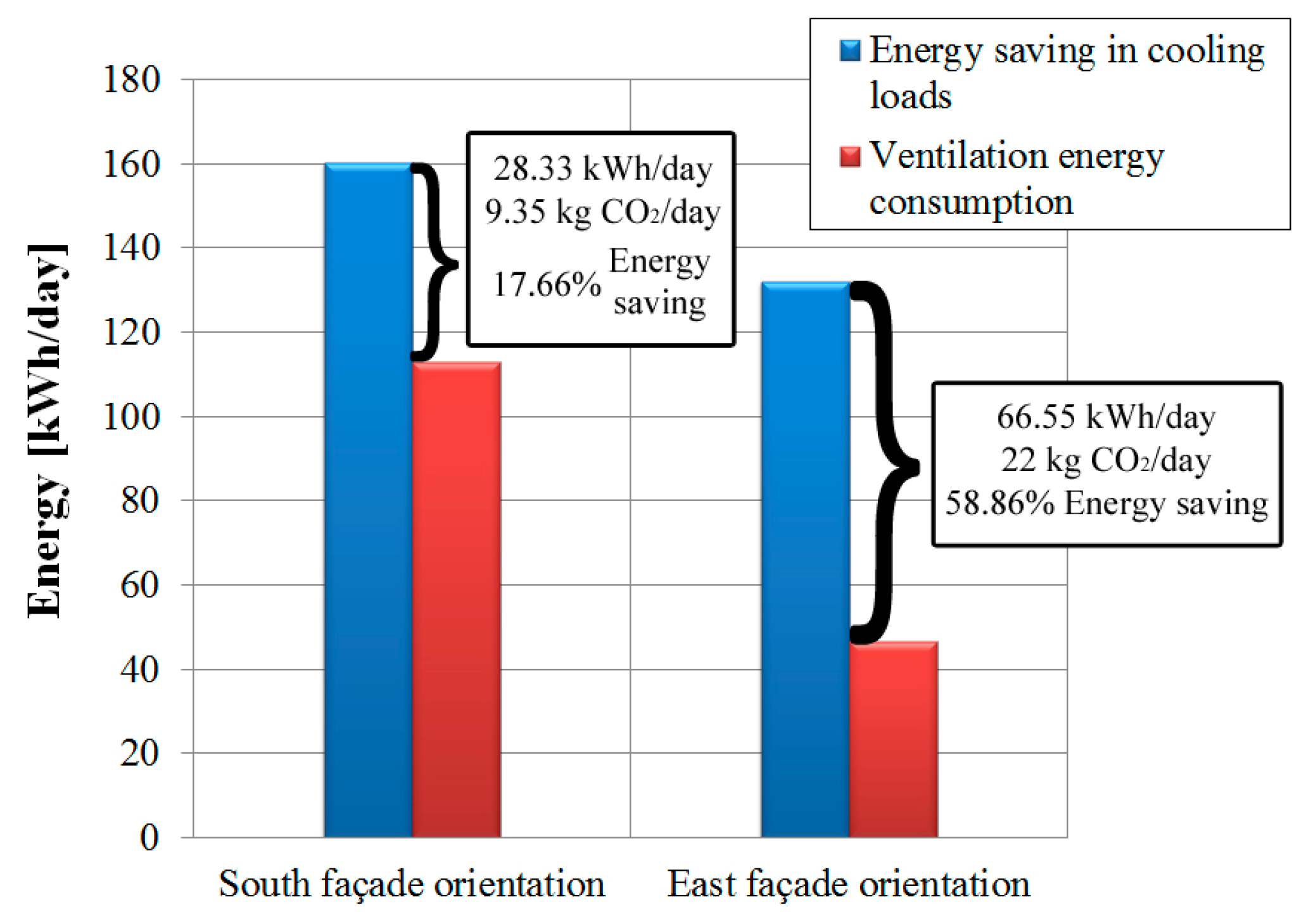
5. Conclusions
Acknowledgments
Conflicts of Interest
References
- Faggembauu, D. Heat Transfer and Fluid-Dynamics in Double and Single Skin Façades. Ph.D. Thesis, Universitat Politècnica de Catalunya, Barcelona, Spain, 2006. [Google Scholar]
- Loncour, X.; Deyener, A.; Blasco, M.; Flamant, G.; Wouters, P. Ventilated Double Façades. Classification & Illustration of Façade Concepts; Belgian Building Research Institute: Limelette, Belgium, 2004. [Google Scholar]
- Poirazis, H. Double Skin Façades for Office Buildings, Literature Review. Division of Energy and Building Design; Report EBD-R-04/3; Department of Construction and Architecture, Lund Institute of Technology: Lund, Sweden, 2004. [Google Scholar]
- Compagno, A. Intelligent Glass Façades; Birkhäuser: Berlin, German, 1995. [Google Scholar]
- Gratia, E.; de Herde, A. Optimal operation of a south double-skin facade. Energy Build. 2004, 36, 41–60. [Google Scholar] [CrossRef]
- Hensen, J.; Bartak, M.; Frantisek, D. Modeling and simulation of a double-skin façade system. ASHRAE Trans. 2002, 108, 1251–1259. [Google Scholar]
- Guardo, A.; Coussirat, M.; Egusquiza, E.; Alavedra, P.; Castilla, R. A CFD approach to evaluate the influence of construction and operation parameters on the performance of active transparent façades in Mediterranean climates. Energy Build. 2009, 41, 534–542. [Google Scholar] [CrossRef]
- Baldinelli, G. Double skin façades for warm climate regions: Analysis of a solution with an integrated movable shading system. Build. Environ. 2009, 44, 1107–1118. [Google Scholar] [CrossRef]
- Manz, H. Total solar energy transmittance of glass double façades with free convection. Energy Build. 2004, 36, 127–136. [Google Scholar] [CrossRef]
- Sedlák, J.; Mráček, P. Simulation of the Double Facade in the Brno Metropolitan Library. In Proceedings of the Dynamic Analysis, Simulation and Testing Applied to the Energy and Environmental Performance of Buildings, DYNASTEE, Athens, Greece, 12–14 October 2005.
- Guardo, A.; Coussirat, M.; Valero, C.; Egusquiza, E.; Alavedra, P. CFD assessment of the performance of lateral ventilation in Double Glazed Façades in Mediterranean climates. Energy Build. 2011, 43, 2539–2547. [Google Scholar] [CrossRef]
- Coussirat, M.; Guardo, A.; Jou, E.; Egusquiza, E.; Cuerva, E.; Alavedra, P. Performance and influence of numerical sub-models on the CFD simulation of free and forced convection in double-glazed ventilated façades. Energy Build. 2008, 40, 1781–1789. [Google Scholar]
- Valentín, D.; Guardo, A.; Egusquiza, E.; Valero, C.; Alavedra, P. Use of Coandă nozzles for double glazed façades forced ventilation. Energy Build. 2013, 62, 605–614. [Google Scholar] [CrossRef]
- Hien, W.N.; Liping, W.; Chandra, A.N.; Pandey, A.R.; Xiaolin, W. Effects of double glazed facade on energy consumption, thermal comfort and condensation for a typical office building in Singapore. Energy Build. 2005, 37, 563–572. [Google Scholar] [CrossRef]
- Haase, M.; Wong, F. Double-skin facades for Hong Kong. Surv. Built Environ. 2007, 18, 17–32. [Google Scholar]
- Saelens, D.; Roels, S.; Hens, H. Strategies to improve the energy performance of multiple-skin facades. Build. Environ. 2008, 43, 638–650. [Google Scholar] [CrossRef]
- Park, C.; Augenbroe, G. Local vs. integrated control strategies for double-skin systems. Autom. Constr. 2013, 30, 50–56. [Google Scholar] [CrossRef]
- Jaroš, M.; Mohelníková, J.; Plšek, D. Glazed Facades and Their Influence on Indoor Climate Buildings. In Proceedings of the CESB 07 Prague Conference, Prague, Czech Republic, 24–26 September 2007. Session M3C: Energy 1.
- Stec, W.J.; van Paassen, A.H.C. Symbiosis of the double skin façade with the HVAC system. Energy Build. 2005, 37, 461–469. [Google Scholar] [CrossRef]
- Cianfrini, C.; Corcione, M.; Habib, E.; Quintino, A. Energy performance of a lightweight opaque ventilated façade integrated with the HVAC system using saturated exhaust indoor air. Energy Build. 2012, 50, 26–34. [Google Scholar] [CrossRef]
- Streicher, W. BESTFAÇADE: Best Practice for Double Skin Façades, WP 1 Report “State of the Art”; Institute of Thermal Engineering, Graz University of Technology: Graz, Austria, 2005. [Google Scholar]
- Karabasov, S.A. Understanding jet noise. Philos. Trans. R. Soc. 2010, 368, 3593–3608. [Google Scholar] [CrossRef]
- Código Técnico de la edificación (in Spanish), Real decreto 314/2066 del 17 de marzo. Sección S1 5, Apartado 2. Gobierno de España. Available online: http://www.codigotecnico.org/cte/export/sites/default/web/galerias/archivos/DB_SI_19feb2010.pdf (accessed on 5 June 2013).
- Mitjà, A. Atlas de Radiació solar a Catalunya; (in Catalan). Institut Català d’Energia: Barcelona, Spain, 2001. [Google Scholar]
- Manz, H.; Frank, Th. Thermal simulation of buildings with double-skin façades. Energy Build. 2005, 37, 1114–1121. [Google Scholar] [CrossRef]
- Lang, H.J. Cost relationships in preliminary cost estimation. Chem. Eng. 1947, 54, 117–121. [Google Scholar]
- Guthrie, K.M. Process Plant Estimating Evaluation and Control; Craftsman Book Co.: Los Angeles, CA, USA, 1974. [Google Scholar]
- Page, J.S. Conceptual Cost Estimating Manual; Gulf Publishing Company: Houston, TX, USA, 1984. [Google Scholar]
- Perry, R.H.; Green, D.W. Perry’s Chemical Engineers’ Handbook, 8th ed.; McGraw-Hill: New York, NY, USA, 2007. [Google Scholar]
- Vatavuk, W.M. Updating the CE plant cost index. Chem. Eng. 2002, 109, 62–70. [Google Scholar]
- Lozowski, D. Economic indicators. Chem. Eng. 2013, 120, 63–64. [Google Scholar]
- Aerzen Ibérica (in Spanish). Available online: http://www.aerzen.es/Productos/Soplantes-Aerzen-de-desplazamiento-positivo (accessed on 25 November 2012).
- Grupo Genser (in Spanish). Available online: http://www.grupogenser.com/PDF/SOPLANTES-KAESER/Cat%C3%A1logo%20Soplante%20Serie%20Compact.pdf (accessed on 25 November 2012).
- Pedro Gil S.L. Available online: http://www.pedrogil.com/docs/1-MANUAL%20INSTR.%20PG-30-F1%20ENG.pdf (accessed on 25 November 2012).
- European Commission “Eurostat”. Available online: http://epp.eurostat.ec.europa.eu/statistics_explained/index.php/Energy_price_statistics (accessed on 30 July 2013).
- Nyman, M.; Simonson, C.J. Life cycle assessment of residential ventilation units in a cold climate. Build. Environ. 2005, 40, 15–27. [Google Scholar] [CrossRef]
- Ortiz-Rodríguez, O.; Castells, F.; Sonnemann, G. Life cycle assessment of two dwellings: One in Spain, a developed country, and one in Colombia, a country under development. Sci. Total Environ. 2010, 408, 2435–2443. [Google Scholar] [CrossRef] [PubMed]
- IDAE Instituto para la Diversificación y Ahorro de la Energía (in Spanish). Available online: http://www.idae.es/index.php/mod.documentos/mem.descarga?file=/documentos_Factores_ConveConve_Energia_y_CO2_2011_0a9cb734.pdf (accessed on 29 July 2013).
- Miranda, A.L. Técnicas de Climatización; (in Spanish). Marcombo, S.A.: Barcelona, Spain, 2010; pp. 47–57. [Google Scholar]
- American Society of Heating, Refrigerating and Air-Conditioning Engineers, Inc (ASHRAE). ASHRAE Handbook Fundamentals; ASHRAE: Atlanta, GA, USA, 2009; Chapters 17–18. [Google Scholar]
© 2013 by the authors; licensee MDPI, Basel, Switzerland. This article is an open access article distributed under the terms and conditions of the Creative Commons Attribution license (http://creativecommons.org/licenses/by/3.0/).
Share and Cite
Valentín, D.; Guardo, A.; Egusquiza, E.; Valero, C.; Alavedra, P. Assessment of the Economic and Environmental Impact of Double Glazed Façade Ventilation Systems in Mediterranean Climates. Energies 2013, 6, 5069-5087. https://doi.org/10.3390/en6105069
Valentín D, Guardo A, Egusquiza E, Valero C, Alavedra P. Assessment of the Economic and Environmental Impact of Double Glazed Façade Ventilation Systems in Mediterranean Climates. Energies. 2013; 6(10):5069-5087. https://doi.org/10.3390/en6105069
Chicago/Turabian StyleValentín, David, Alfredo Guardo, Eduard Egusquiza, Carme Valero, and Pere Alavedra. 2013. "Assessment of the Economic and Environmental Impact of Double Glazed Façade Ventilation Systems in Mediterranean Climates" Energies 6, no. 10: 5069-5087. https://doi.org/10.3390/en6105069
APA StyleValentín, D., Guardo, A., Egusquiza, E., Valero, C., & Alavedra, P. (2013). Assessment of the Economic and Environmental Impact of Double Glazed Façade Ventilation Systems in Mediterranean Climates. Energies, 6(10), 5069-5087. https://doi.org/10.3390/en6105069






